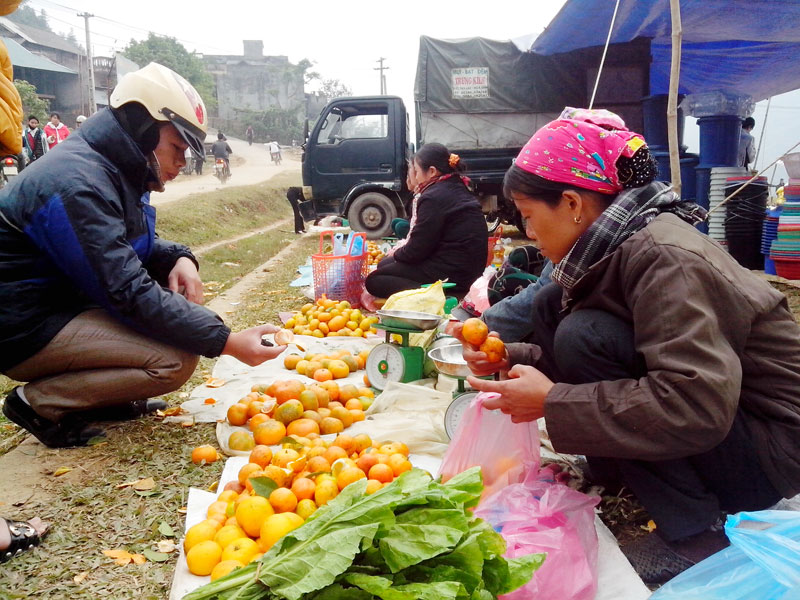
(HBO)- Highland fairs in commune at the end of the year are exciting and busy. This is the center of the 5 highland communes of Tan Lac district, so every market people from different parts of the communes are always taking part. Rearranging the goods for the market, Ms. Bui Thi Nga living in Bac Son commune happily says: "In the past, there were all dirty land roads in these communes. It was very difficult hard to travel. Now there are asphalted roads and people travel to work by motorbike, they do not have to walk any more. People go straight to the market or upland field. Thanks to the roads, many families in my commune have escaped from poverty due to selling goods they have made.
 \
\
Thanks to the convenient transportation, people in Nam Son commune (Tan
Lac) bring tangerines favored by customers to Lung Van market to sell.
Back to the road to the upland communes such as Quyet
Chien, Ngo Luong, Lung Van, Nam Son and Bac Son, people’s lives are prospering.
Starting from the key crop of maize to reduce poverty, the people boldly
restructured plants bringing some high-value plant varieties into production,
typically chayote trees, sweet tangerines and purple garlic ones. Ms. Dinh Thi
Quyet, the chairwoman of the Quyet Chien Safe Vegetables Cooperative says that
the convenient roads have made it much easier for the people to consume
vegetables. A lot of the households have expanded the area of growing chayote
and other vegetables. Now every day, there are three to four trucks carrying
vegetables there to Hanoi and other provinces to consume.
In the
past year, the State has upgraded and repaired narrow parody road sections,
which are out of sight. As a result of this, the roads to the upland communes
of Tan Lac district is smooth and have limited the danger. Thanks to the
strengthening intensive farming methods and safe VietGAP production procedures,
the planting area of chayote in Quyet Chien commune has formed a sustainable
agricultural value chain. Tan Lac chayote products are now consumed in big
markets, reaching a chain of restaurants and supermarkets of agricultural
products and foodstuffs in Hanoi and some other provinces and cities
According to data from the Hoa Binh Provincial Party Committee, the industrial production index for the first six months of 2025 is estimated to have increased by 20% compared to the same period last year. This marks the highest year-on-year growth rate for this period since 2020.
In the first six months of 2025, Hoa Binh province’s export turnover was estimated at 1.145 billion USD, marking an 18.11% increase compared to the same period in 2024. Import turnover was estimated at $ 804 million, a 17.15% increase, which helped the province maintain a positive trade balance.
The lives of the ethnic minority farmers in Tan Lac district have gradually improved thanks to the new directions in agricultural production. This is a testament to the collective strength fostered through the professional associations and groups implemented by various levels of the district’s Farmers’ Union.
With the motto the "product quality comes first,” after nearly one year of establishment and operation, Muong village’s Clean Food Agricultural and Commercial Cooperative, located in Cau Hamlet, Hung Son Commune (Kim Boi district), has launched reputable, high-quality agricultural products to the market that are well-received by consumers. The products such as Muong village’s pork sausage, salt-cured chicken, and salt-cured pork hocks have gradually carved out a place in the market and they are on the path to obtaining the OCOP certification.
In the past, the phrase "bumper harvest, rock-bottom prices" was a familiar refrain for Vietnamese farmers engaged in fragmented, small-scale agriculture. But today, a new spirit is emerging across rural areas of Hoa Binh province - one of collaboration, organisation, and collective economic models that provide a stable foundation for production.
Maintaining growing area codes and packing facility codes in accordance with regulations is a mandatory requirement for agricultural products to be eligible for export. Recently, the Department of Agriculture and Environment of Hoa Binh province has intensified technical supervision of designated farming areas and packing facilities to safeguard the "green passport" that enables its products to access international markets.



 \
\